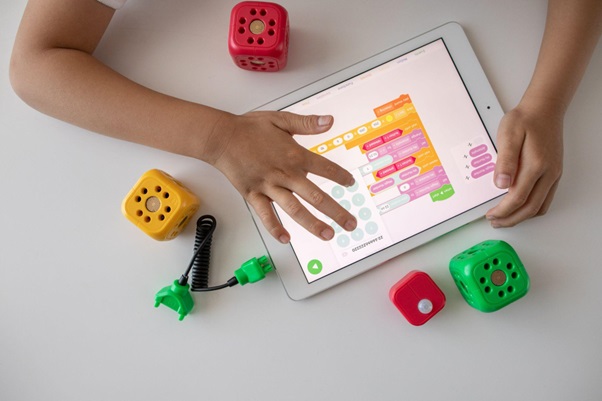Home »
Articles
Coding in Early Childhood Education: Age-Appropriate Approaches and Activities
By IncludeHelp Last updated : October 31, 2023

In today's world, technology is everywhere and coding is becoming super important. Think of it as the magic behind our favourite games, apps, and websites.
As our lives get more digital, knowing how to code is becoming as essential as knowing how to read or do basic maths.
This is why it's a great idea to introduce kids to coding when they're still young. It prepares them for the future and helps them think better, solve problems, and be more creative.
Starting early gives them a head start, makes learning fun, and opens a world of possibilities for their future careers and interests.
The Importance of Coding for Kids
Coding is more than just computer programming. It's a toolset that prepares kids for a rapidly changing future, enriching their personal and professional lives.
- Problem-Solving Skills: Coding teaches kids how to approach complex challenges and break them down into manageable tasks, promoting analytical thinking.
- Creativity: Coding allows kids to bring their ideas to life, be it through games, AI animations, or apps, fostering innovation and imaginative thinking.
- Resilience: Encountering errors and bugs teaches kids persistence, patience, and the value of learning from mistakes.
- Maths Skills: Coding often involves mathematical concepts, thereby strengthening maths skills and making abstract concepts more tangible.
- Understanding the Digital World: As digital natives, it's essential for kids to understand the mechanics behind their everyday digital interactions, fostering informed digital citizens.
- Job Opportunities: The tech sector continues to grow, and coding skills open doors to numerous career opportunities in various fields.
- Enhanced Communication: Explaining and documenting code helps kids in refining their communication skills, especially in being precise and clear.
- Adaptability: In the ever-evolving tech landscape, learning to code teaches kids to be adaptable, continuously learning, and staying updated.
- Logical Reasoning: Programming requires structured thinking and understanding cause and effect, enhancing logical reasoning abilities.
- Confidence Building: Successfully creating a program or fixing a bug instils a sense of achievement and boosts self-confidence.
Age-Appropriate Approaches and Activities
i) Toddlers (Ages 2-4)
Toddlers, with their boundless energy and curiosity, are primed for learning, even if the topic is as intricate as coding. But of course, you wouldn't introduce a 3-year-old to Java or Python directly.
Instead, the goal is to instil the foundational concepts of coding in ways that resonate with their playful nature. Here's how:
-
Conceptual Understanding Through Play
- Sequences and Patterns: At this age, everything can be a game. Activities like arranging coloured blocks in a specific order or creating patterns with beads introduce toddlers to the idea of sequences, a crucial coding concept.
- Cause and Effect: Simple games where pressing a button yields a result (like a pop-up toy) can subtly teach the concept of input leading to an output, a basic coding principle.
-
Offline Activities
- Coding Toys: There are toys specifically designed for toddlers that encourage coding logic. For example, a toy caterpillar that moves based on different segment arrangements can introduce the idea of step-by-step instructions.
- Board Games: Simple board games that involve following a set of directions can lay the groundwork for coding comprehension.
-
Unplugged Coding Activities
- Set up a maze using cushions and guide the toddler through it using basic commands like "move forward," "turn right," etc. This activity mimics the fundamental commands in coding.
-
Repetition is Key
- Just like reading a favourite story repeatedly, revisit coding activities regularly. Repetition reinforces learning and helps toddlers grasp complex concepts over time.
ii) Preschoolers (Ages 4-6)

As children grow and enter their preschool years, their cognitive abilities expand, and their readiness for more structured learning takes root.
Introducing coding at this stage can be a delightful blend of education and play. Here's how we can engage preschoolers in the fascinating world of coding:
-
Interactive Apps and Games
- Beginner Coding Apps: Numerous apps designed specifically for this age group offer a playful introduction to coding. Apps like "Daisy the Dinosaur" and "Kodable" employ visual programming to teach foundational concepts.
- Puzzle Games: Games that challenge kids to solve problems and follow sequences can be an indirect introduction to coding logic.
-
Block-Based Coding Platforms
- Tools like ScratchJr are ideal for preschoolers. By allowing children to create interactive stories and games, they grasp the essence of coding: giving instructions and watching them play out.
-
Hands-On Activities
- Robotics Kits for Kids: There are basic robotics kits tailored for preschoolers, like Bee-Bot. Kids can program the robot to move in certain directions, offering a tactile coding experience.
- Crafts with Sequence: Activities like stringing beads in a pattern or following steps to create a craft project can underscore the importance of sequence in coding.
-
Group Activities and Games
- Collaborative Coding: Set up tasks that require teamwork. Children can work together to "code" a solution, emphasising the collaborative nature of coding.
- Physical Coding Games: Games like "coding hopscotch," where each square represents a command, can be both physically active and mentally stimulating.
iii) Early Elementary (Ages 6-8)
As children transition into the early elementary phase, their cognitive and motor skills have matured, enabling them to delve deeper into coding.
They may begin with spending time on coding platforms that will allow them to understand coding in a real, practical way.
The key at this stage is to present coding as both fun and challenging, harnessing their growing analytical and problem-solving capabilities.
Here are some strategies tailored for early elementary students:
-
Advanced Block-Based Coding Platforms
- Scratch: Developed by MIT, Scratch allows kids to create animations, stories, and games using drag-and-drop code blocks. It's a perfect tool for understanding sequencing, loops, and basic programming logic.
- CodeMonkey: Another platform that offers visually appealing coding puzzles, helping kids advance their coding skills step by step.
-
Coding with Real Languages
- Kid-Friendly Python: While it might sound advanced, simple Python projects can be introduced to kids at this age, especially using platforms like CodeCombat or tools like Turtle graphics.
-
Robotics and Hardware Kits
- LEGO Boost: This kit allows children to build and code their robots, combining hands-on building and digital coding.
- Ozobot: A small robot that can be programmed using colour-coded sequences, blending artistic creativity with coding concepts.
-
Games and Puzzles
- Coding Board Games: Games like "Robot Turtles" and "Code Master" introduce programming logic through playful board game mechanics.
- Online Coding Games: Websites like Code.org offer interactive puzzles that teach core coding concepts in a gamified manner.
-
Field Trips and Workshops
- Visiting tech companies and science centres or attending coding workshops can provide real-world context to their learning and fuel their enthusiasm.
Challenges and Considerations in Introducing Coding to Young Learners
Introducing coding to children, while immensely beneficial, isn't without its hurdles. Here are some challenges and considerations to bear in mind:
-
Screen Time Concerns
- Balancing Act: While many coding activities are digital, there's a growing concern about increasing screen time for children. Finding a balance between offline and online coding activities is crucial.
- Active vs. Passive Screen Time: Not all screen time is equal. Interactive learning through coding is far more valuable than passive consumption.
-
Keeping Engagement High
- Varied Interests: Just as kids have diverse interests in books or sports, their interest in coding can vary. It's essential to align coding activities with their personal interests.
- Avoid Repetition: Repeating the same coding tasks can bore kids. Keep things fresh with new challenges and platforms.
-
Avoiding Overwhelm
- Complexity Levels: Pushing children into complex coding tasks before they're ready can lead to frustration. It's vital to match activities to their current skill level.
- Setting Realistic Expectations: It's okay if a child doesn't become an overnight coding prodigy. The journey is as valuable as the outcome.
- Cost of Resources: Coding toys, apps, and platforms can be expensive. It's essential to find effective and affordable resources, ensuring all kids have access.
-
Safety and Privacy
- Online Safety: If children are using online platforms, ensuring these platforms are safe and free from inappropriate content is paramount.
- Data Privacy: Some coding apps and websites might collect user data. Being aware of privacy policies and ensuring children's data is protected is essential.
Conclusion
In the digital age, coding has emerged as a crucial skill akin to the literacy and numeracy of past generations.
Starting early, from toddlers to elementary students, offers kids a significant edge.
However, it's not just about learning a computer language but cultivating logical thinking, problem-solving, and creativity.
While challenges exist, from screen time concerns to accessibility, the benefits are undeniable.
By navigating these challenges wisely, we prepare our young ones for a future where they don't just consume technology but actively shape it.
Advertisement
Advertisement